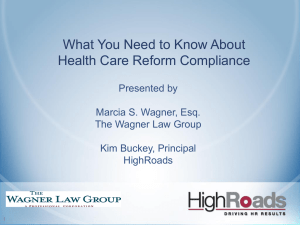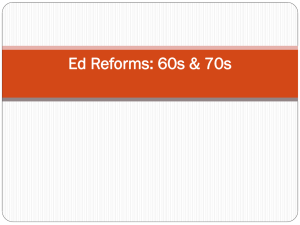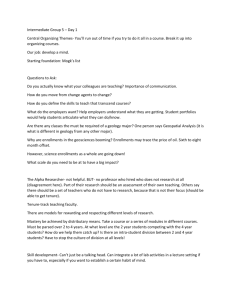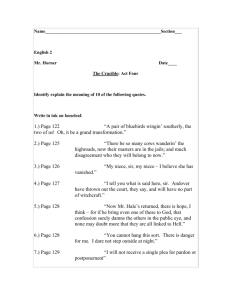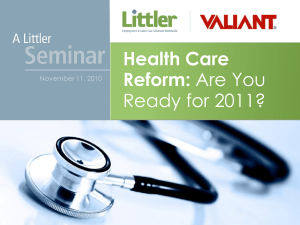View Barry Newman's webinar here
advertisement
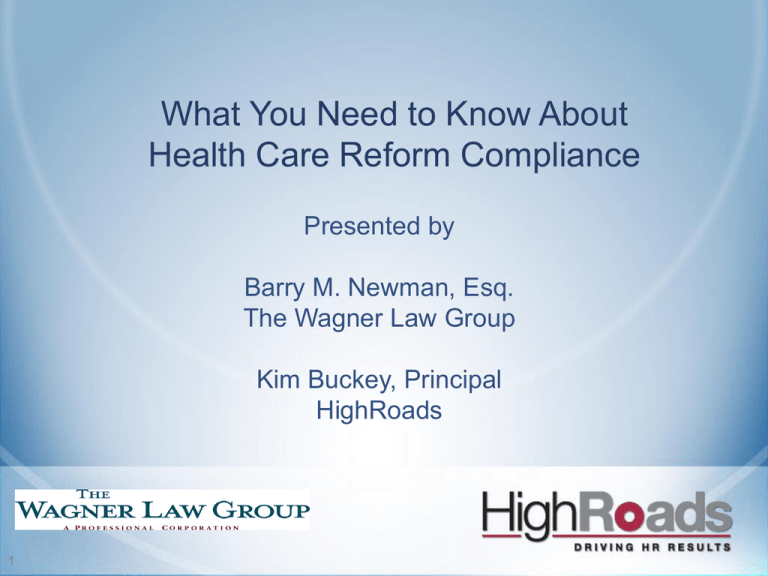
What You Need to Know About Health Care Reform Compliance Presented by Barry M. Newman, Esq. The Wagner Law Group Kim Buckey, Principal HighRoads 1 Introductions – Barry M. Newman Barry M. Newman is a senior attorney at The Wagner Law Group, specializing in employee benefits law, concentrating on employersponsored health and welfare plans including: benefit plan documentation, ERISA reporting and disclosure, COBRA, HIPAA, cafeteria plans, retiree health benefit issues, VEBAs, and benefit plan taxation and nondiscrimination requirements. He is co-author, subject matter expert, and editor of several texts, including Quick Reference to ERISA Compliance, The FMLA Guide and The COBRA Compliance Guide. Introductions – Kim Buckey Kim Buckey is the Principal for the HighRoads Communications consulting practice focused on delivering high value strategic and practical solutions for clients in an efficient manner leveraging the HighRoads technology platform. Previously, Kim served as national compliance champion and global quality leader for Watson Wyatt's communication practice. In her 30-year career Buckey has helped dozens of companies meet their compliance requirements by completing hundreds of health and welfare and retirement plan SPDs. From the Beginning • It’s now been 8 months since the Health Care Reform Act was signed into law • By now you’re all pretty familiar with the basics, and the provisions that required your immediate attention • You should have already: • • • • determined if your plan has grandfathered status extended coverage to adult children to age 26 removed lifetime limits from your plans held special enrollment periods for those who had aged out or previously hit lifetime limits • made required plan document and benefit changes 4 What’s Next • What do you need to consider for the next 12-18 months? – – – – – – – – – Required notices Maintaining grandfathered status Internal and external review procedures OTC drugs & FSA limits Retiree coverage subsidy W2 reporting Auto enrollments Benefit summaries Advance notice of material changes 5 Required Notices • • • • Grandfathered Health Plan Notice Special Enrollment for Adult Children Lifetime Limits Notice Patient Protection Notice Grandfathered Status • You may have GF status for 2011, but does it make sense going forward? • Can it realistically be maintained—cost to provide coverage will likely go up as vendors raise costs, so employer will need to balance appropriate cost sharing with GF status benefits • Reminder of how GF status is lost – – – – New contract or policy Increase in cost sharing Decrease in employer contribution New annual limits 7 Provisions Applicable to All Plans • Coverage for adult children • Restrictions on annual and lifetime benefit limits • Elimination of pre-existing condition exclusions • Limitation of rescissions 8 Provisions Applicable to Non-Grandfathered Plans • Provide free preventative care services • Participants may select primary care providers, including pediatric care providers, and OB/GYNs • Emergency care services without prior authorization • Insured group health plans will be subject to nondiscrimination rules • Internal and External Appeals Process Internal and External Reviews • Internal – Comply with DOL’s current claims requirements plus six new requirements including: • Urgent care claims resolved within 24 hours • Plan must hire independent decision makers • Must provide “culturally and linguistically appropriate” notices • External – Comply with state external review process for insured plans, or – Comply with procedures in new DOL Technical Release FSA Changes • OTC drugs other than insulin can no longer be reimbursed through account-based plans without a prescription as of 1/1/11 – Plan year and grace period do not change effective date – Applies only to medicines and drugs – Debit card use suspended • HC FSAs limited to $2,500 effective. January 1, 2013 • Plan Amendments 11 Retiree Coverage Subsidy • Discuss subsidy employers were receiving for continuing to provide retiree medical coverage in light of Medicare Part D • Impact that elimination of this subsidy will have – Now (need to reflect this on the books) – Future (need to decide whether to stay in retiree med biz) 12 W2 Reporting • What it is… • Dodged a bullet (we have a reprieve) 13 Auto enrollments – General rule – When does it apply – How will it be applied 14 Uniform Explanation of Coverage • Standards to be developed by HHS within 12 months of enactment – March 23, 2011 – No Longer than four pages – Culturally and linguistically appropriate – Applies to plans March 23, 2012 Notice of Modifications • 60-Day and advance notice for any material modification in: – Terms of plan – Coverage involved Administrative Concerns • What do you need to do to be ready? – Internal administrative procedures – Working with your vendors 17 Communicating About Health Care Reform • Employees are looking for information about how health care reform will affect them and their benefits 18 There’s a Lot to Communicate Year Topics 2011 • OTC drugs no longer eligible medical expenses • W-2 reporting 2012 Benefit summaries Advance notice of material changes 2013 • Changes to FSA contribution limit • Information about the Exchange and how employer plan coordinates 19 Your Options Approach Pros Cons Update your SPDs • • • May be out of compliance anyway Long shelf life • Issue SMMs • • Other tools (enrollment materials, newsletters, meetings) • • Often less costly to produce and mail Can be generated relatively quickly • Timely May have more visual impact • • May not have time before the end of the year, especially if you have many, or complex, SPDs Can be costly to produce May get separated from SPDs Fulfillment may be a challenge (who gets what) Likely to end up in the trash 20 What’s Next? – Summaries of coverage • Distributed on or before March 30, 2012, and at enrollment – 60-day advance notice of changes to benefits (effective 2012) 21 You Need a Plan • The volume, frequency and complexity of changes over the coming years demand a strategy • Map out: – – – – – – – – What needs to be communicated when When guidance is coming from HHS Who needs what information when Who needs to review and approve what information What decisions will need to be made about benefit strategy and design What is best timing/media to get messages across Who’s going to do the work How can technology help 22 Why worry? 23 Penalties • $110 per day penalty for failure to provide compliant SPD • Potential back benefits & court fees if SPD found to be lacking • HIPAA Penalties: – $100 to $50,000 based on number and nature of violations – Maximum penalty $1,500,000 per year – Separate violation occurs on each day of noncompliance 24 Conclusion – Action Steps for Employers Determine if you should keep grandfathered status Assess plan with regards to new requirements, including claims review procedures Prepare for: – Required open enrollments and automatic enrollments – New required communication materials and notices – Revisions of summary plan descriptions and new summaries of material modifications – Keep Alert! Government agencies will be issuing additional regulations and revising those that have already been issued 25 Q&A Have a question later? Ask the Experts Barry Newman Tel: (617) 357-5200 bnewman@wagnerlawgroup.com Website: www.erisa-lawyers.com Kim Buckey Tel: (781) 503-4000 x 3085 kbuckey@highroads.com Blog: http://newsroom.highroads.com/ Thank you Thank for attending today’s webinar. You will be receiving several reference materials - Electronic distribution guideline SPD Content Checklist What Plans Require an SPD Best Practices of Health Care Reform Compliance article by the presenters
